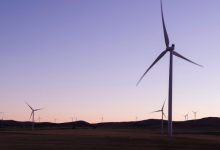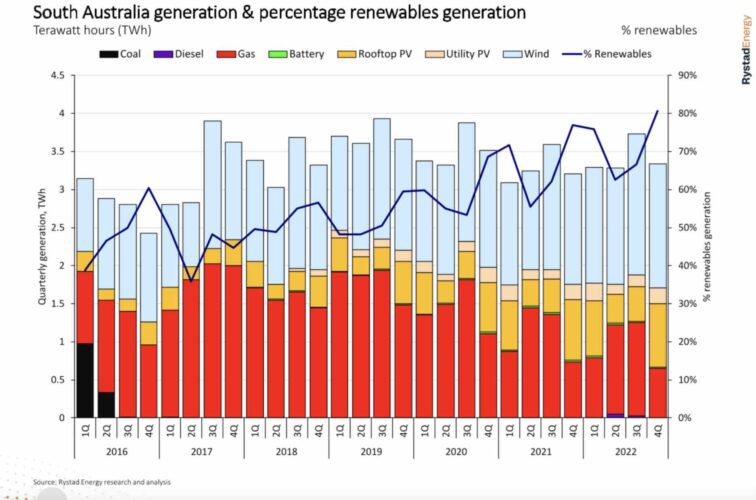The South Australia electricity grid may finally have delivered the answer to one of the most intractable problems facing governments and energy markets around the world: How to escape the tyranny of soaring gas prices.
The answer is wind and solar, lots of it. While modest amounts of wind and solar – between five and fifty per cent – can deliver some relief from the expensive gas generators that mostly set the highest prices in the market – it appears that it is not until a grid reaches extremely high levels of wind and solar that the yoke is broken.
Rystad Energy’s David Dixon has noted that in the December quarter, spot electricity prices in South Australia were trading at a significant discount to gas prices as the share of wind and solar in the state surpassed quarterly average of 80 per cent for the first time.
This is important. There has long been a direct correlation between the price of gas, and gas generation, and average wholesale electricity prices. This has become a major problem around the world since the Russian invasion of Ukraine sent fossil fuel prices soaring around the world.
It has also become a problem for governments arguing that wind and solar are the cheapest forms of energy and will lead to lower prices. The difficulty is that as long as expensive gas holds sway over price setting, those reductions are hard to see.
These graph shows that as the share of renewables in South Australia jumps (see graph below), and the dependence on gas since the closure of its last coal generators declines, prices have fallen.
Instead of spot prices being at a premium to the gas price, they have been at a discount, particularly in the December quarter when wind and solar are at their best. Wind and solar reached 80 per cent in the latest December quarter and the high 70s (pct) in the December quarter of 2021.
The recent growth in renewables in South Australia has been boosted by the ongoing big uptake of rooftop solar in the state – at an average of more than 200MW a year – and the addition of major new projects such as the Port Augusta Renewable Energy Hub, the biggest wind and solar hybrid in the country.
The good news for South Australia, Dixon notes, is that the situation is going to get even better as more and more wind and solar join the grid, along with storage.
Over the next couple of years at least another 500MW of new capacity will be added, including Neoen’s 412 MW Goyder South wind farm (which will be the biggest in the state) and Vena Energy’s 90 MW Tailem Bend 2 solar farm.
Dixon says that together these two projects are estimated to add 1.2 terawatt-hours (TWh) per year to the state’s generation or nine per cent of its total generation. Another 200-250MW of rooftop solar PV will add a further 0.4 TWh/year of additional supply.
The big change, however, will be the completion of the major new transmission link, Project Energy Connect, which will be able to export, or import, up to 800 MW to and from.
“It will be transformational,” Dixon writes in a LinkedIn post, in reference to the huge number of solar and hydro assets in southern NSW, and the additional projects that will be unlocked by the new link.
It will also mean a lot less curtailment of wind and solar, which happens when the current export links to Victoria reach their capacity. And that will mean more periods when the share of wind and solar over local demand is well over 100 per cent. Even rooftop solar on its own has reached that level.
The writing is already on the wall for gas in South Australia. AGL is closing down the last of its ageing gas plants and is keeping only a handful of modern fast-start generators that will only be used for a few hours a year.
The day to day dispatchable generation work will be taken up by battery storage, including its new Torrens Island battery – being built at the site of its ageing gas plants – that should come into full operation by the middle of this year, overtaking the Hornsdale Power Reserve – the original Tesla big battery – as the biggest in the state.












